Top Food Markets in Japan – Experience Authentic Flavors
Japan is not only renowned for its ancient temples, cherry blossoms, and technological marvels but also for its rich and diverse culinary culture. One of the best ways to experience the authentic flavors of Japan is by visiting the top food markets in Japan. These bustling hubs offer a sensory overload of fresh seafood, regional specialties, street food delights, and unique produce, providing both locals and travelers an opportunity to savor Japan’s culinary heritage.
From the world-famous Tsukiji Market in Tokyo to the local delights of Nishiki Market in Kyoto, exploring these vibrant marketplaces reveals the heart and soul of Japanese cuisine. This guide will take you through the most iconic food markets in Japan, highlighting where you can sample authentic dishes, discover local ingredients, and soak in the energetic atmosphere.
Why Food Markets Are a Must-Visit in Japan
Food markets in Japan are a reflection of the nation’s deep-rooted respect for seasonal ingredients, precision in food preparation, and culinary diversity. Visiting the top food markets in Japan is more than just shopping for groceries—it’s a cultural experience where you interact with passionate vendors, sample freshly prepared street food, and witness centuries-old traditions in food preparation.

1. Tsukiji Outer Market (Tokyo)
Although the inner wholesale fish market has moved to Toyosu, the Tsukiji Outer Market remains one of the top food markets in Japan, drawing food lovers from around the world.
Highlights:
-
Fresh Seafood: Sashimi, sushi, oysters, and uni (sea urchin) served fresh.
-
Kitchenware Shops: Knives, cookware, and unique utensils.
-
Street Food Stalls: Grilled seafood, tamagoyaki (Japanese omelet), and more.
Insider Tip:
Visit early in the morning to avoid crowds and experience the freshest offerings.
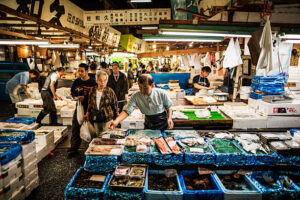
2. Nishiki Market (Kyoto)
Known as “Kyoto’s Kitchen,” Nishiki Market is a must-visit for anyone seeking the authentic flavors of traditional Kyoto.
Highlights:
-
Pickled Vegetables (Tsukemono): Specialty local varieties.
-
Yuba (Tofu Skin): Delicate dishes unique to Kyoto.
-
Seasonal Produce: Fruits, seafood, and Kyoto-specific specialties.
Cultural Insight:
This market has been operating for over 400 years, blending local history with gastronomy.
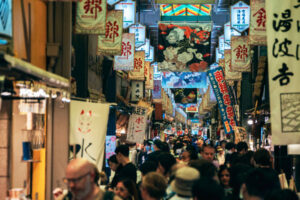
3. Kuromon Ichiba Market (Osaka)
Kuromon Ichiba Market is famous for its dynamic atmosphere and is a top destination among food markets in Japan for seafood lovers.
Highlights:
-
Fresh Takoyaki and Sushi: Made-to-order delights.
-
Grilled Wagyu Beef: Sample high-quality cuts prepared on the spot.
-
Fruits and Vegetables: Locally grown and seasonal varieties.
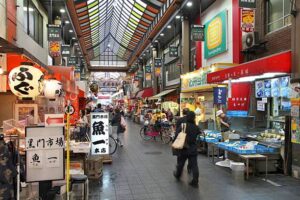
4. Omicho Market (Kanazawa)
Omicho Market offers a traditional Japanese market experience with a focus on seafood from the Sea of Japan.
Highlights:
-
Fresh Crab and Seafood: Rich in flavor and diversity.
-
Local Specialties: Kaga vegetables and local delicacies.
-
Seasonal Offers: Reflect the region’s agricultural calendar.
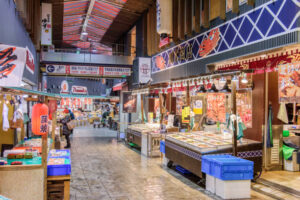
5. Sapporo Central Wholesale Market (Hokkaido)
One of the top food markets in Japan, especially for seafood, is Sapporo Central Wholesale Market, located in Hokkaido, known for its cold-climate marine produce.
Highlights:
-
Uni and Crab: Exceptionally fresh and abundant.
-
Hokkaido Dairy Products: Cheese, milk, and ice cream.
-
Market Restaurants: Sushi bars and seafood rice bowls.
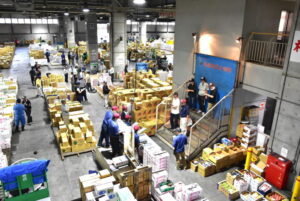
6. Ameyoko Market (Tokyo)
Ameyoko Market in Ueno is a bustling market combining the charm of post-war Japan with modern energy.
Highlights:
-
International Flavors: Spices, dried seafood, sweets, and meats.
-
Street Food: Yakitori, takoyaki, and steamed buns.
-
Local and Imported Goods: A mix of traditional and contemporary products.
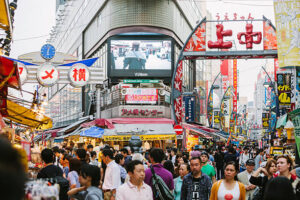
7. Hakodate Morning Market (Hokkaido)
Hakodate Morning Market is ideal for early risers looking for fresh seafood and local produce in a traditional setting.
Highlights:
-
Kaisendon (Seafood Rice Bowl): Fresh seafood over rice.
-
Local Squid Dishes: Unique and specialty offerings.
-
Fruit Stalls: Regional fruits and seasonal picks.
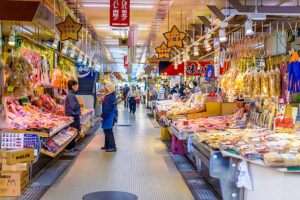
8. Yatai Food Stalls (Fukuoka)
While not a market in the traditional sense, Fukuoka’s Yatai stalls are an essential part of experiencing food markets in Japan.
Highlights:
-
Ramen Stalls: Famous Hakata ramen.
-
Grilled Meats: Skewers and seafood.
-
Friendly Atmosphere: Open-air and casual dining.
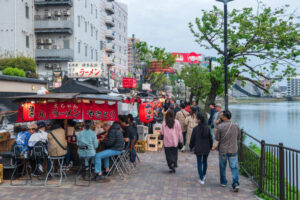
9. Local Produce Markets – Regional Gems
Beyond the well-known tourist spots, every region in Japan has local produce markets offering a glimpse into its agricultural richness.
Examples:
-
Karato Market (Shimonoseki): Famous for fresh blowfish (fugu).
-
Omi-cho Market (Kanazawa): Known for local fish and vegetables.
-
Local Farmer’s Markets: Seasonal fruits, vegetables, and artisanal products.
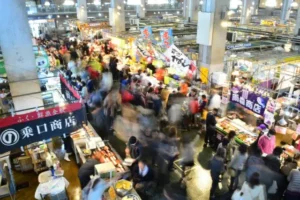
Food Market Etiquette – Respect and Tradition
-
Bargaining: Generally not practiced; prices are fixed.
-
Sampling: Many stalls allow you to sample small portions.
-
Cleanliness: Always dispose of trash in designated areas.
-
Politeness: Greet vendors and thank them using “Arigatou gozaimasu.”
Practical Tips for Exploring Japan’s Food Markets
-
Early Visit: Markets are freshest in the morning.
-
Cash Only: Most stalls do not accept cards.
-
Bring a Reusable Bag: Some vendors offer plastic bags, but it’s eco-friendly to use your own.
-
Language: Knowing basic Japanese food terms can help.
Sample Food Market Itinerary in Japan
Day 1: Tokyo
-
Morning: Visit Tsukiji Outer Market for fresh sushi and seafood.
-
Afternoon: Explore Ameyoko Market for snacks and international goods.
Day 2: Kyoto
-
Morning: Nishiki Market for Kyoto’s local specialties and pickled vegetables.
-
Afternoon: Visit a traditional tea house to complement your market experience.
Day 3: Osaka
-
Morning: Kuromon Ichiba Market for fresh produce, grilled meats, and street food.
-
Evening: Explore Dotonbori’s food stalls.
Conclusion – Savor Authentic Flavors in Japan’s Markets
The top food markets in Japan are a vibrant fusion of history, flavor, and community. From the fresh seafood at Tsukiji and Hakodate markets to the traditional sweets of Nishiki, these markets offer an unparalleled cultural and culinary adventure. Every bite, interaction, and aroma tells the story of Japan’s deep connection to nature, tradition, and innovation.
Plan your trip to coincide with local market days and experience firsthand the authentic tastes and cultural richness that make Japan’s food markets a must-visit.
Follow Us: Instagram